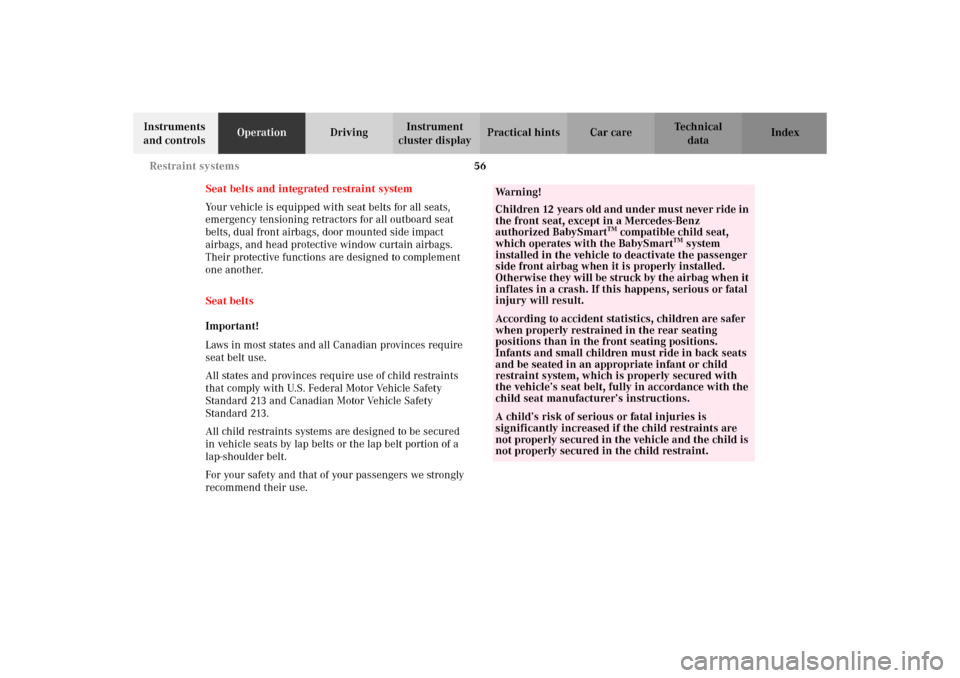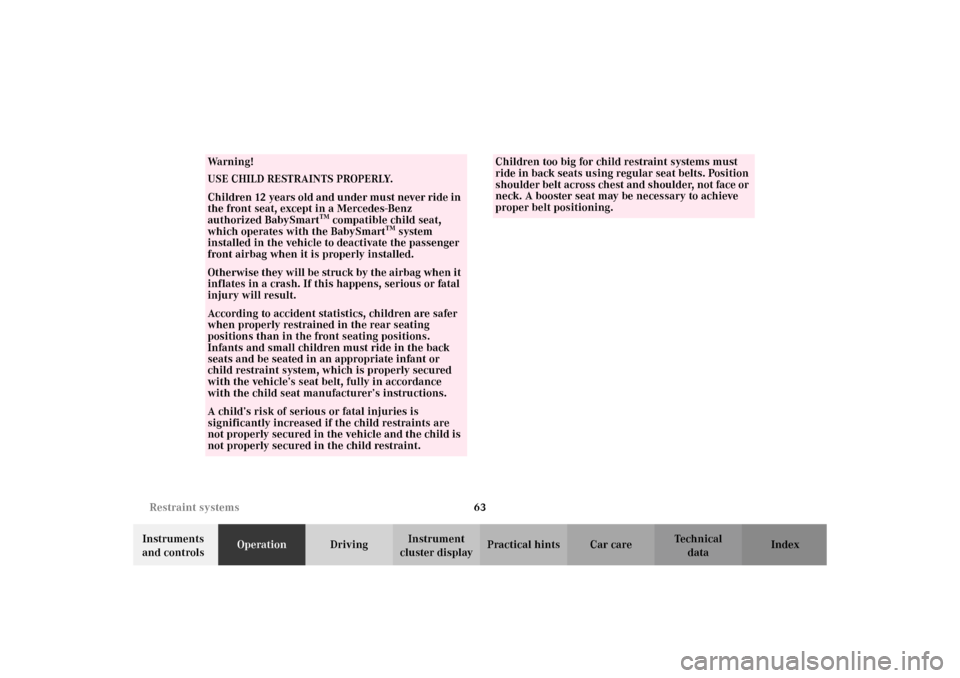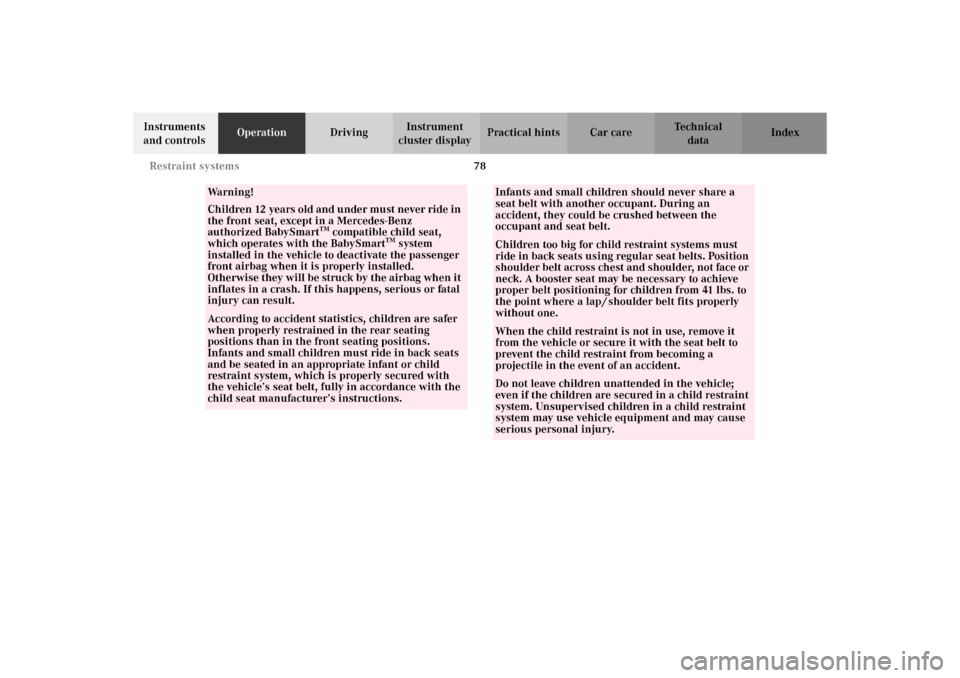2002 MERCEDES-BENZ C320 WAGON ECU
[x] Cancel search: ECUPage 5 of 390

2 Contents
Trip and main odometer
and sub menu ............................ 100
Audio systems ................................ 102
Radio ............................................ 102
CD player ..................................... 103
Cassette player ........................... 104
Telephone ........................................ 105
Navigation system ...........................110
Trip computer ..................................111
Malfunction/warning
message memory .......................113
Individual settings ..........................115
Setting the audio volume .............. 130
Coolant temperature gauge .......... 131
Flexible service system
(FSS) ............................................ 132
Engine oil level indicator .............. 135
Engine oil consumption ................ 136
Exterior lamp switch ..................... 137
Headlamp mode ............................. 138
Night security illumination ......... 140
Locator lighting .......................... 141
Headlamp cleaning system .......... 141
Combination switch ...................... 142Rear window wiper / washer ...... 146
Hazard warning flasher
switch ......................................... 147
Automatic climate control ............ 148
Front center console storage
compartment ventilation ..........159
Rear passenger compartment
adjustable air outlets ................160
Operation Audio and telephone ... 161
Operating safety ............................. 161
Operating and display elements ..162
Button and soft key operation ......164
Operation .........................................164
Switching on and off ......................164
Adjusting the volume ....................165
Audio functions ..............................165
Bass ..................................................165
Treble ...............................................165
Balance .............................................166
Centering all audio functions .......166
Audio system tone level selection 167
Radio mode ......................................167
Selecting radio mode .....................167
Selecting the band .........................167Manual tuning ................................ 168
Seek tuning ..................................... 168
Scan tuning ..................................... 168
Weather Band ................................. 169
Station memory .............................. 169
Storing stations automatically
(Autostore) ................................. 169
Storing stations .............................. 170
Retrieving a station
from memory ............................. 170
Direct frequency
input AM and FM only ............. 170
Cassette mode ................................ 170
Playing cassettes ............................ 170
Cassette eject .................................. 171
Track selection ............................... 172
Track search
forwards/backwards ................. 172
Fast forward/reverse ..................... 172
Scanning ......................................... 173
Scanning ......................................... 173
Dolby NR 1
noise reduction system ............ 173
CD mode .......................................... 174
S203.book Seite 2 Freitag, 19. Oktober 2001 1:25 13
Page 30 of 390

27 Contents - Operation
Te ch n i c a l
data Instruments
and controlsOperationDrivingInstrument
cluster displayPractical hints Car care Index Coolant temperature gauge .......... 131
Flexible service system
(FSS) ............................................ 132
Engine oil level indicator .............. 135
Engine oil consumption ................ 136
Exterior lamp switch ..................... 137
Headlamp mode ............................. 138
Night security illumination ......... 140
Locator lighting .......................... 141
Headlamp cleaning system .......... 141
Combination switch ...................... 142
Rear window wiper / washer ....... 146
Hazard warning flasher
switch .......................................... 147
Automatic climate control ............ 148
Front center console storage
compartment ventilation ......... 159
Rear passenger compartment
adjustable air outlets ................ 160Operation Audio and telephone ... 161
Operating safety ............................. 161
Operating and display elements ..162
Button and soft key operation ......164
Operation .........................................164
Component malfunctions ..............183
Power windows ...............................185
Sliding/pop-up roof ........................188
Interior lighting .............................. 191
Sun visors ........................................193
Vanity mirrors ................................193
Interior .............................................194
Storage compartments
and armrests ..............................194
Glove box ......................................195
Cup holder .......................................198
Ashtrays .......................................... 200
Lighter ............................................. 202Parcel net in
front passenger footwell ..........203
Ski sack ...........................................203
Parcel net in trunk ........................208
Electrical outlet ..............................209
Storage compartment
under trunk floor ......................209
Retractable luggage cover
and partition net ....................... 210
Split rear bench seat ..................... 213
Loading instructions ..................... 217
Cargo tie-down rings ..................... 218
Cellular telephone ......................... 219
Telephone, general ........................220
Garage door opener ....................... 221
S203.book Seite 27 Freitag, 19. Oktober 2001 1:25 13
Page 32 of 390

29 Central locking system
Te ch n i c a l
data Instruments
and controlsOperationDrivingInstrument
cluster displayPractical hints Car care Index Electronic key
The electronic key has an integrated radio frequency
and infrared remote control, plus removable mechanical
key.
The remote control (1) operates all locks on the vehicle.
The mechanical key (2) works only in the driver’s door,
tailgate, and glove box lock.When using the mechanical key (2) for lock operations,
it can be removed by sliding it out of the remote control.
To do so, move locking tab (3) to the right and slide the
mechanical key (2) in direction of arrow (4).
The remote control transmitter is located in the
electronic key.
The infrared receivers are located in the front door
handles.
Note:
Remove the mechanical key from the electronic key
when using valet parking service. To prevent access to
storage compartments lock them separately and retain
the mechanical key.
See page 41 for separate locking of tailgate and page 195
for locking of glove box.
Obtaining replacement keys
Your vehicle is equipped with a theft deterrent locking
system requiring a special key manufacturing process.
For security reasons, replacement keys can only be
obtained from your authorized Mercedes-Benz Center.
P80.35-2030-26
1
3
4
2
S203.book Seite 29 Freitag, 19. Oktober 2001 1:25 13
Page 52 of 390

49 Seats
Te ch n i c a l
data Instruments
and controlsOperationDrivingInstrument
cluster displayPractical hints Car care Index Important!
Prior to operating the vehicle, the driver should check
and adjust if necessary the seat height, seat position
fore and aft, and backrest angle to insure adequate
control, reach and comfort. The head restraint should
also be adjusted for proper height. See also airbag
section on page 67 for proper seat positioning.
In addition, also adjust the steering wheel to ensure
ad eq uate con tr ol, r each, operation and com fort. B ot h the
inside and outside rear view mirrors should be adjusted
for adequate rearward vision.
Fasten seat belts. Infants and small children should be
seated in a properly secured restraint system that
complies with U.S. Federal Motor Vehicle Safety
Standard 213 and Canadian Motor Vehicle Safety
Standard 213.
All seat, head restraint, steering wheel, and rear view
mirror adjustments as well as fastening of seat belts
should be done before the vehicle is put into motion.
Wa r n i n g !
Children 12 years old and under must never ride in
the front seat, except in a Mercedes-Benz
authorized BabySmart
TM compatible child seat,
which operates with the BabySmart
TM system
installed in the vehicle to deactivate the passenger
side front airbag when it is properly installed.
Otherwise they will be struck by the airbag when it
inflates in a crash. If this happens, serious or fatal
injury can result.
According to accident statistics, children are safer
when properly restrained in the rear seating
positions than in the front seating positions.
Infants and small children must ride in back seats
and be seated in an appropriate infant or child
restraint system, which is properly secured with
the vehicle’s seat belt, fully in accordance with the
child seat manufacturer’s instructions.A child’s risk of serious or fatal injuries is
significantly increased if the child restraints are
not properly secured in the vehicle and the child is
not properly secured in the child restraint.
S203.book Seite 49 Freitag, 19. Oktober 2001 1:25 13
Page 59 of 390

56 Restraint systems
Te ch n i c a l
data Instruments
and controlsOperationDrivingInstrument
cluster displayPractical hints Car care Index
Seat belts and integrated restraint system
Your vehicle is equipped with seat belts for all seats,
emergency tensioning retractors for all outboard seat
belts, dual front airbags, door mounted side impact
airbags, and head protective window curtain airbags.
Their protective functions are designed to complement
one another.
Seat belts
Important!
Laws in most states and all Canadian provinces require
seat belt use.
All states and provinces require use of child restraints
that comply with U.S. Federal Motor Vehicle Safety
Standard 213 and Canadian Motor Vehicle Safety
Standard 213.
All child restraints systems are designed to be secured
in vehicle seats by lap belts or the lap belt portion of a
lap-shoulder belt.
For your safety and that of your passengers we strongly
recommend their use.
Wa r n i n g !
Children 12 years old and under must never ride in
the front seat, except in a Mercedes-Benz
authorized BabySmart
TM compatible child seat,
which operates with the BabySmart
TM system
installed in the vehicle to deactivate the passenger
side front airbag when it is properly installed.
Otherwise they will be struck by the airbag when it
inflates in a crash. If this happens, serious or fatal
injury will result.
According to accident statistics, children are safer
when properly restrained in the rear seating
positions than in the front seating positions.
Infants and small children must ride in back seats
and be seated in an appropriate infant or child
restraint system, which is properly secured with
the vehicle’s seat belt, fully in accordance with the
child seat manufacturer’s instructions.A child’s risk of serious or fatal injuries is
significantly increased if the child restraints are
not properly secured in the vehicle and the child is
not properly secured in the child restraint.
S203.book Seite 56 Freitag, 19. Oktober 2001 1:25 13
Page 66 of 390

63 Restraint systems
Te ch n i c a l
data Instruments
and controlsOperationDrivingInstrument
cluster displayPractical hints Car care Index
Wa r n i n g !
USE CHILD RESTRAINTS PROPERLY.Children 12 years old and under must never ride in
the front seat, except in a Mercedes-Benz
authorized BabySmart
TM compatible child seat,
which operates with the BabySmart
TM system
installed in the vehicle to deactivate the passenger
front airbag when it is properly installed.
Otherwise they will be struck by the airbag when it
inflates in a crash. If this happens, serious or fatal
injury will result.According to accident statistics, children are safer
when properly restrained in the rear seating
positions than in the front seating positions.
Infants and small children must ride in the back
seats and be seated in an appropriate infant or
child restraint system, which is properly secured
with the vehicle’s seat belt, fully in accordance
with the child seat manufacturer’s instructions.A child’s risk of serious or fatal injuries is
significantly increased if the child restraints are
not properly secured in the vehicle and the child is
not properly secured in the child restraint.
Children too big for child restraint systems must
ride in back seats using regular seat belts. Position
shoulder belt across chest and shoulder, not face or
neck. A booster seat may be necessary to achieve
proper belt positioning.
S203.book Seite 63 Freitag, 19. Oktober 2001 1:25 13
Page 80 of 390

77 Restraint systems
Te ch n i c a l
data Instruments
and controlsOperationDrivingInstrument
cluster displayPractical hints Car care Index Infant and child restraint systems
We recommend all infants and children be properly
restrained at all times while the vehicle is in motion. All
lap-shoulder belts except the driver seat belt have
special seat belt retractors for secure fastening of child
restraints.
To activate, pull shoulder belt out completely and let it
retract. During the seat belt retraction a ratcheting
sound can be heard to indicate that the special seat belt
retractor is activated. The belt is now locked.
To deactivate, release seat belt buckle and let seat belt
retract completely. The seat belt can again be used in
the usual manner.
Note:
For child seats with mounting fittings for tether
anchorages refer to page 79 (installation of infant and
child restraint systems).Important!
The use of infant or child restraints is required by law in
all 50 states and all Canadian provinces.
Infants and small children should be seated in an
appropriate infant or child restraint system properly
secured by a lap-shoulder belt, and that complies with
U.S. Federal Motor Vehicle Safety Standard 213 and
Canadian Motor Vehicle Safety Standard 213.
A statement by the child restraint manufacturer of
compliance with this standard can be found on the
instruction label on the restraint and in the instruction
manual provided with the restraint.
When using any infant or child restraint system, be sure
to carefully read and follow all manufacturer’s
instructions for installation and use.
Please read and observe warning labels affixed to inside
of vehicle and to infant or child restraints.
Wa r n i n g !
Never release the seat belt buckle while vehicle is
in motion, since the special seat belt retractor will
be deactivated.
S203.book Seite 77 Freitag, 19. Oktober 2001 1:25 13
Page 81 of 390

78 Restraint systems
Te ch n i c a l
data Instruments
and controlsOperationDrivingInstrument
cluster displayPractical hints Car care Index
Wa r n i n g !
Children 12 years old and under must never ride in
the front seat, except in a Mercedes-Benz
authorized BabySmart
TM compatible child seat,
which operates with the BabySmart
TM system
installed in the vehicle to deactivate the passenger
front airbag when it is properly installed.
Otherwise they will be struck by the airbag when it
inflates in a crash. If this happens, serious or fatal
injury can result.
According to accident statistics, children are safer
when properly restrained in the rear seating
positions than in the front seating positions.
Infants and small children must ride in back seats
and be seated in an appropriate infant or child
restraint system, which is properly secured with
the vehicle’s seat belt, fully in accordance with the
child seat manufacturer’s instructions.
Infants and small children should never share a
seat belt with another occupant. During an
accident, they could be crushed between the
occupant and seat belt.Children too big for child restraint systems must
ride in back seats using regular seat belts. Position
shoulder belt across chest and shoulder, not face or
neck. A booster seat may be necessary to achieve
proper belt positioning for children from 41 lbs. to
the point where a lap / shoulder belt fits properly
without one.When the child restraint is not in use, remove it
from the vehicle or secure it with the seat belt to
prevent the child restraint from becoming a
projectile in the event of an accident.Do not leave children unattended in the vehicle;
even if the children are secured in a child restraint
system. Unsupervised children in a child restraint
system may use vehicle equipment and may cause
serious personal injury.
S203.book Seite 78 Freitag, 19. Oktober 2001 1:25 13